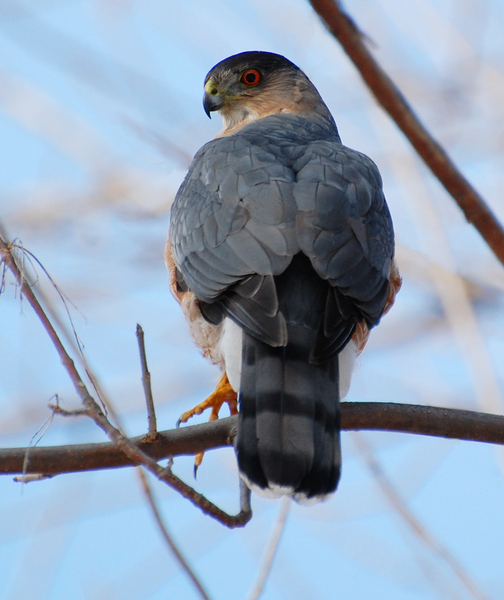
It's begun
March 15th, 2011
Migration has begun. In fact, it's well underway! Four spring firsts at Mud Lake this morning: Canada Geese by the dozens, several Red-Winged Blackbirds singing on territory, a pair of Hooded Mergansers, and last but not least, five Wood Ducks--the earliest I've ever seen that species in Ottawa. These early birds arrive in a land still crusted with snow and ice, still below freezing at night and with precious few natural food sources. They tough it out so they can claim their breeding grounds early.
Ring-Billed Gulls have been reported back in Ottawa as of March 1st--my first sighting was a few days ago. They're everywhere now. Some people turn up their noses at this common, noisy urban species, but I like them. They're quite handsome up close, in their crisp breeding plumage, and their tameness affords the opportunity for excellent photos.
Brant
March 13th, 2011
Another one from the backlog. This is the Brant goose who lingered at Andrew Haydon park a couple years ago.

1680x1050 wallpaper
Success
March 12th, 2011
I found this one lurking in my backlog. In retrospect it deserved attention long before now! This is a Ring-Billed Gull fishing the rapids near Carleton University--photographed April 2009.

1680x1050 wallpaper
Detail:

Gimme
March 10th, 2011
House Finches don't go to the sunflower feeder one by one like the chickadees do. Small finches don't typically believe in this concept of "taking turns." They all pile on at once, as many as can fit and occasionally more than that! It tilts and spins as they come and go.

A Finchy Assortment
March 9th, 2011
The Hurdman feeders are heaven for bird-lovers right now. Redpolls galore, house finches galore, goldfinches galore, cardinals. And everyone singing!

Upper left: male Common Redpoll. Upper right: female House Finch. Below: American Goldfinches. The goldfinch on the left is beginning to molt into his bright breeding plumage: notice the lemon-yellow spot on his belly, and the mottling of bright and dingy yellow on his face. The male redpolls are becoming more colorful too.
Hanging in there
February 28th, 2011
All winter this Hermit Thrush has spent at my local feeders--and survived, well north of his usual wintering grounds. This despite the fact that, according to several reports and my own observations, he has a bum foot. He lives on dried fruit that people scatter on the ground for him, bits of fallen suet from the woodpecker feeders, and the occasional sunflower seed.
Here's hoping that he successfully convalesces and returns to the wild. I remember seeing the 2007/08 Hurdman Hermit Thrush in the spring thaw, still lingering in the area, but no longer dependent on humans--he was back where he belonged, hopping around in wet woods picking newly emerged insects out of the underbrush. I wish the same for this fellow!

1680x1050 wallpaper
Cooper's Hawk
February 27th, 2011
There was quite a panic at the Hurdman feeders when this visitor flew in. Hint: he wasn't there to eat birdseed.

Chowing down
February 22nd, 2011

Male Pileated Woodpecker at the Shirley's Bay feeders.
Bohemian Waxwings
February 21st, 2011
I've been chasing these guys all winter. They finally sat still for me!


1680x1050 wallpaper


Waxwings are sociable and gentle birds, and sharing berries (one will pluck it, then feed it to another) is one way they show friendliness to their flockmates. This behavior is especially common among mated pairs.

Many of them were feeding on the ground--presumably on fallen berries. I managed one quick shot of this cluster before they scattered.
A rear view showing this bird's strikingly colored wings:

American Tree Sparrow
February 14th, 2011
This boreal sparrow is marked by a chestnut cap and a single, diffuse black spot on an otherwise unmarked breast. It has a less than accurate name: it breeds in tundra and nests on the ground. Even on its wintering grounds (which include Ottawa), it prefers open areas to woods. I see them at marshes in Stony Swamp and at the edges of farmer's fields in the west end.
But the number one place to find Tree Sparrows in Ottawa is the Shirley's Bay feeders. There's always a flock of them there in winter. They forage in the snow and on the rocks, where people leave piles of birdseed for them. Next time I go back I think I'll give them a proper photo shoot. I snapped just a few pictures of this guy between photographing redpolls.

1680x1050 wallpaper

|
